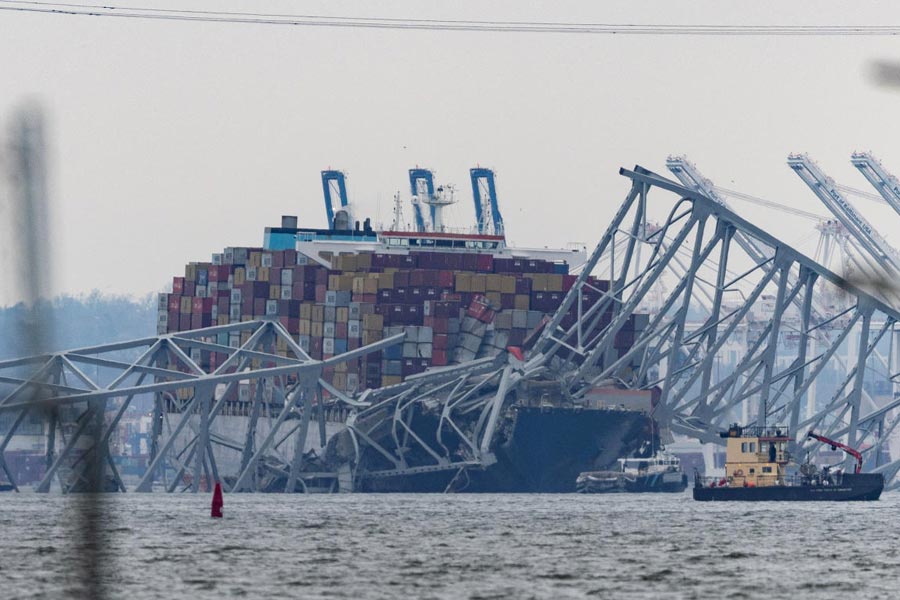They came to the United States for a chance at a better life. They found work filling pot holes on a bridge in the middle of the night, and they ended up dead in the Baltimore harbor.
The six victims of the Francis Scott Key Bridge collapse were all immigrants from Mexico and Central America, doing the kind of grueling work that many immigrants take on, when a container ship crashed into a support pillar at 1:30 a.m. EDT on Tuesday (0530 GMT) and sent them plunging into the icy Patapsco River.
Divers pulled the bodies of Alejandro Hernandez Fuentes and Dorlian Castillo from a red pickup truck 25 feet underwater the following day.
Four are missing and presumed dead: Maynor Suazo from Honduras; Jose Lopez from Guatemala; Miguel Luna from El Salvador; and another whose name has not been released. Another two workers were rescued.
The news rippled quickly through Baltimore's Hispanic community, which has nearly doubled in size in recent years, transforming the modest rowhouse neighborhoods near the sprawling port complex. Churches held vigils for the missing workers, and advocacy groups quickly raised $98,000 for the victims' families.
Some said they were not surprised that all of the victims were immigrants, even though they account for less than 10% of the population in Maryland's largest city.
"One of the reasons Latinos were involved in this accident is because Latinos do the work that others do not want to do. We have to do it, because we come here for a better life. We do not come to invade the country," said Lucia Islas, president of Comité Latino de Baltimore, a nonprofit group.
Hispanic workers are more likely than other racial and ethnic groups to die on the job, according to the U.S. Bureau of Labor Statistics, with construction being a particularly deadly industry.
Government and industry figures show that Hispanics are over-represented in high-risk jobs: 51% of construction workers, 34% of slaughterhouse workers and 61% of landscaping workers.
The workers on the Key Bridge were employed by Brawner Builders Inc, a local construction company that has done extensive work for the state and has been cited seven times since 2018 for safety violations. Company officials have said they are devastated by the loss, and declined comment when contacted by Reuters.
Community leaders said many Hispanics in the city take low-paying work that provides scant benefits.
"The only choice is to work, when you don't have the same salary that a citizen might earn," said Carlos Crespo, 53, a mechanic from Mexico.
"Many don't value our Hispanic community. They see us as animals or think that we live off the government. But that is not true, we pay our taxes too," he said.
Crespo and others involved in the fundraising effort said it was built on years of similar attempts to help provide a safety net for people who struggle to find affordable health care and adequate housing or navigate services that are only provided in English.
'WAIT WITH FAITH, HOPE'
"We go from one crisis to another," said Susana Barrios, vice president of the Latino Racial Justice Circle.
The disaster comes in the middle of a U.S. presidential election in which immigration is once again a top concern for voters, as Democratic President Joe Biden's administration has struggled to manage a recent record number of border crossings.
Republican candidate Donald Trump has employed racist rhetoric against immigrants, referring to them as "animals" and "not people" on the campaign trail and has said he would dramatically ramp up deportation if re-elected on Nov. 5.
Baltimore, which has struggled with high crime and a poverty rate nearly double the national average, historically hasn't been home to a large Hispanic population, but the community has grown in recent years. Hispanics made up 7.8% of the city's population in 2020, up from 4.2% in 2010, according to U.S. Census figures.
Nelson Amaya, a pastor of a Pentecostal church in the nearby suburb of Severn, said many Central American immigrants have moved from nearby Washington, D.C., suburbs in search of jobs and more affordable housing. Many Hispanic markets, restaurants and other businesses have opened in recent years, he said.
"In more or less the last five years, the Hispanic population here has grown a lot," he said. "That has a big, big impact on the economy."
The White House said on Thursday that existing immigration rules could allow for relatives of the victims who are abroad to visit the United States.
In the meantime, some struggled to come to grips with their loss.
"We continue to wait with faith, with hope, that our brother's body can be found so that we can begin the repatriation process, which is what interests us most," said Martin Suazo, brother of one of the missing, in Azacualpa, Honduras.
"We believe they should not forget the suffering of the families of the four victims whose bodies have not been found."











